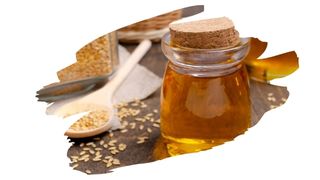Are you worried about fine lines or cracks appearing on your work? Aren’t we all.
It happens to even the best of us when we’re working with green wood. You see, green wood is simply a catch-all term referring to freshly logged timber.
When wood is still ‘green’ it has a lot of moisture in it. But, as that moisture begins to evaporate, wood can begin to shrink and contract. And if wood dries out too quickly, that’ll speed up that shrinking process to the point of causing cracks.
So, what can we do to prevent wood from cracking? And can Linseed oil provide a possible solution to this age-old woodworking problem?
Well, in this post, you will discover exactly what causes wood to crack — and why a simple milling process called ‘seasoning’ is key to preventing wood from splitting.
You will also learn the two best ways to stop wood from fracturing. And keep reading to find out whether or not Linseed oil can really help to fend off those hairline splits.

This post may contain affiliate links to products that we receive a commission for (at no additional cost to you). Learn more here.
Why Does Wood Crack And Split When It Dries?
It all comes down to moisture.
Freshly milled lumber has a lot of moisture saturating its wood fibers. This is often referred to as woods ‘moisture content’. And freshly logged wood has a moisture content of around 100%.
But all of that excess moisture can make wood unstable. Especially once that moisture starts to evaporate.
So, before we begin working with wood, we need to leave it to dry out. And this drying out process is called ‘seasoning’.
Now, wood that is left to air-dry and season can take 6-12 months to dry. After which, it’s moisture content will have reduced to under 19%.
However, as wood dries out, it shrinks and contracts. And this is still the case even if you start working with wood before it’s been properly seasoned.
Now, the faster wood dries out, the faster it shrinks. And if it shrinks too quickly and unevenly, it will form splits and splinters. And those splits are known as wood checking.

And once wood starts to check, it becomes brittle and starts to split apart.
OK. So How Do You Keep Wood Furniture From Cracking?
The only way to prevent wood from cracking is to try and slow down the evaporation process. Why? Well, because the faster moisture escapes, the worse things are going to be for your wooden craft.
So, there are two main ways you can do this;
1). Regulate The Humidity In The Room
This basically involves regulating the moisture in the air around wood. As long as you keep the humidity levels at around 45% to 65%, you’ll slow down the rate of evaporation.
Now, the easiest way to decrease the humidity is with a dehumidifier or air conditioning unit. And the simplest way to raise the humidity is with a vaporizer or cool steam machine.
But regulating the humidity in an area isn’t always the straightforward (or practical) way to go about preventing cracking.
Which is why your best option is to instead…
2). …Apply A Sealant
This approach involves coating wood with a waterproofing sealant that will prevent water vapor from escaping wood.
Applying a sealant, (particularly over exposed end grain), will keep wood from drying out and warping.
Related Post: What To Do When Solid Wood Cabinet Doors Start Warping (Solved!)
An end grain sealer, for example, is the go-to product for sealing wood turning logs. By coating the exposed end grain, you can prevent a log from cracking.
However, you would tend to use a waterproofing sealant to do this (typically a polyurethane or urethane sealant). This is particularly true if you are based in a very hot climate.
You see, more popular wood finishes, such as Tung oil or Danish oil, are microporous finishes. So, while they can slow down evaporation, they aren’t waterproof enough to provide a sealing coat through hot weather.
And What Do You Mean By Microporous Finish?
A microporous finish is what we call a wood finish that is water-repellent, but not waterproof. These finishes can stop water droplets from getting past their coat. Yet, they are not waterproof enough to prevent water vapor from seeping through.
This is why microporous finishes, like Tung oil, become damaged if you place a steaming cup of coffee on them. The combination of heat plus condensation can sink right past Tung oil and down into the wood underneath.
What About Linseed Oil? Will Linseed Oil Stop Wood From Cracking?
Well, Linseed oil is a microporous wood finish. So, in very hot dry climates, even multiple coats of cured Linseed oil won’t help prevent hairline fractures.
Having said that, if you saturate wood with Raw Linseed oil, it’ll sink down into the grain and coat those wood fibers. And, by the mere act of that oil coating those fibers, that should slow down evaporation.
However, when it comes to Raw Linseed oil and moisture, you may find yourself dealing with another problem; mold.
You see, Linseed oil is made from flaxseed, so it contains food proteins. And mold bacteria will happily feed upon those proteins.
Now, this is a problem, because of the fact that Raw Linseed oil cures incredibly slowly. This oil finish may take a few days to dry — but it can take up to 10 weeks to cure into a hard resin film.
Related Post: How To Make Linseed Oil Dry Faster (What You Need To Know)
So, if a Linseed oil finish becomes damp, (i.e. the wood you put it on has lot of moisture in it), it can encourage the growth of mold. And, thanks to Linseed oils long curing time, bacteria have plenty of time to grow on this finish.
Related Post: Is Boiled Linseed Oil A Safe Wood Finish For Garden Beds?
Nevertheless, you can side-step the issues of slow-drying and/or mold by using Boiled Linseed oil (BLO) instead. Thanks to chemical additives, BLO cures so fast that mold never gets a chance to grow on it.
Now, a few coats of BLO will go a long way towards preventing wood checking — if you happen to live in a mild climate area.
However, BLO is simply a preventative measure, not a solution. It won’t stop already cracked brittle wood from splitting even further.
And, in very dry climates, this microporous finish won’t be of much help at all.
To Wrap Up, Here Are The 3 Key Takeaways From This Post…
- 1). Wood cracking is caused by moisture evaporating. If the moisture content in wood evaporates too unevenly, wood will shrink and begin to crack.
- 2). The best way to prevent cracking is to slow down the rate of evaporation. You can do this by either regulating the humidity levels around wood, or by sealing wood with a waterproofing sealer.
- 3). Linseed oil is a water-repellent finish, but it is not a waterproof sealant. This means that — especially in very hot dry climates — Linseed oil isn’t going to prevent water vapor from quickly escaping wood.



